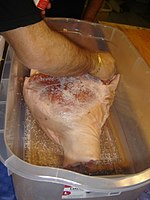
Photo from wikipedia
In this work, grape anthocyanins (GA) were embedded in bacterial nanocellulose (BNC) by ex-situ method to fabricate an easy-to-use colorimetric label. The label revealed visible color responses to the pH… Click to show full abstract
In this work, grape anthocyanins (GA) were embedded in bacterial nanocellulose (BNC) by ex-situ method to fabricate an easy-to-use colorimetric label. The label revealed visible color responses to the pH buffers (2-11). According to the color parameter results [L*, a*, b*, and total color difference (TCD)], the label also presented appropriate color stability during the 60-day storage. During the application in minced beef, the label was bright red on the 1st day of storage at 4 °C. In accordance with the meat quality parameters [TVB-N, total mesophilic count, and sensory attributes], the label turned into purplish-red color on the 3rd and 5th days of storage (medium freshness meat) and turned into blue on the 7th day, representing the spoilage state. All the mentioned color changes could be distinguished by naked eyes. A strong Pearson's correlation coefficient was obtained between the TCD values and meat quality parameters, confirming the capability of the pH-sensing label to correctly distinguish the fresh meat from the spoiled meat.
Journal Title: International journal of biological macromolecules
Year Published: 2020
Link to full text (if available)
Share on Social Media: Sign Up to like & get
recommendations!